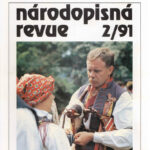THE SIGNIFICANT JUBILEE (HUNDRED YEARS OF THE JOURNAL "ČESKÝ LID")
Josef Jančář
One hundred years ago a specialized journal of etnography "Český lid" (The Czech Folk) was founded. Its beginnings have not been connected with the necessity of the scholarly study of folk culture only, but also with the cultural and political situation of that time. The first editors of the journal (C. Zíbrt and L. Niederle) accentuated the process of the understanding of the specific cultural features of the Czech and Slovak nations and their contribution to European culture in general. The understatement of these efforts consisted in the idea of the Slavonic mutuality which was one of the leading cultural and political ideas at that time.
The article is completed by the preface to the first number of the journal "Český lid" (The Czech Folk) which represents the programmatic declaration and the first compact conception of Czech scholarly ethnography. A great number of these subjects has kept its topical character even in our times.
THE MORAVIAN ETHNOGRAPHICAL EXHIBITIONS IN THE END OF THE 19TH CENTURY
Miloš Melzer
The ethnographical activity which started to develop by the end of the 19th century on the scholarly basis in Bohemia, also found its response in Moravia. Earlier the most active association was the Patriotic Association of Museums in Olomouc which focused its attention on the collecting of ethnographical objects. The new increasing interest to ethnography inspired a great number of volunteers in smaller towns and in the country. The Moravian ethnographical exhibitions which were held mostly in 1892-1894 represented only necessary preparations for the most important event - the Ethnographical Czech-Slavonic Exhibition in 1895. Their organization was associated with the presentation of the most varied forms of cultural and economic life; the inseparable part of the exhibitions was represented by ethnographical festivals. The political aspect of this activity stressed and strengthened national consciousness. One of the results of these exhibitions was the acquiring of the numerous valuable collections which gave birth to many new museums.
THE PLACES OF PILGRIMAGE IN MORAVIA
Marie Čeňková
The present study analyzes the problems which had not been intentionally discussed for many years, although in real life they have continually existed. Various bans and persecution made the visits to the places of pilgrimage extremely difficult. In Moravia and in the adjacent part of Silesia there are 130 popular or less known places of pilgrimage; some of them have had deep historical roots (Velehrad, Hostýn), others came into existence quite recently. The predominant number of Moravian places of pilgrimage has been connected with the cult of the Holy Virgin, the rest commemorates various-saints (most of all St. Anne and St. Anthony), the Trinity and the mysteries of Jesus' life. Except their religious meaning the places of pilgrimage has had a great importance for people's social communication.
THE FEATURES OF AUTHORSHIP AMONG THE FOLK PRODUCERS FROM EASTERN BOHEMIA
Karel Severin
The majority of historical documents of folk production and creative culture is completely anonymous. The anonymity is, however, just illusory because every object bears the expression of the creativeness, art and craftsmanship of each individual. Therefore there are quite different conditions for a more profound investigation of the authorship if we know the name and the place of residence of the craftsman, are acquainted with his life and are able to illustrate his activity with the collection of dated products. The author of the article analyzes the work of the three craftsmen from eastern Bohemia: the two anonymous joiners who produced furniture at the break of the 18th and 19th centuries - and the potter Jin Pivonka (1663-1723) from Česká Třebová. The author writes about the common creative principles, e. g. the tendency to preserve elementary models in morphology and ornaments (composition and lusters of motifs). These traditions, acquired in youth and preserved during the whole productive age, evidently played an important role in the formation of the local forms of folk creative culture.
WE HAVE BEEN EDUCATED AT A GOOD SCHOOL... (LEGS JANACEK'S LETTERS TO MARTIN ZEMAN)
Jindřich Uher
The compositor Leoš Janáček had a great number of collaborators in the Moravian country who collected folk-songs and helped him to organize national cultural and social festivals. One of them was Martin Zeman (1854-1919) from Velká nad Veličkou in south-eastern Moravia. The author publishes some parts from the correspondence dealing with Janacek's research visits to this remarkable (from the point of view of music and songs) locality and with the preparatory work for the forthcoming Ethnographical Czech-Slavonic Exhibition held in Prague in 1895.
THE SONG FOR A NOTEBOOK
Antonín Jančík
The article contains the famous actor Karel Höger's favourite song and his reflections of folk art.
THE FOLKLORE ENSEMBLES AT THE CROSSROADS? (THE INTERVIEW WITH J. M. KRIST NOT ONLY ABOUT FOLKLORE ENSEMBLES)
Jiří Pajer
The editors of the journal asked the director of the City Centre of Culture in Brno J. M. Krist, the significant representative of the ensemble movement in Moravia, several questions concerning further development of folklore ensembles and folk culture in general. The folklore ensembles find themselves in the crisis connected with the lack of financial means necessary for their activity. But they are just formal, extrinsic problems; the core of their creativeness is still on a very high level which represents a good precondition for the overcoming of operational barriers and for further creative activity. It may bring purity and inner experience.



